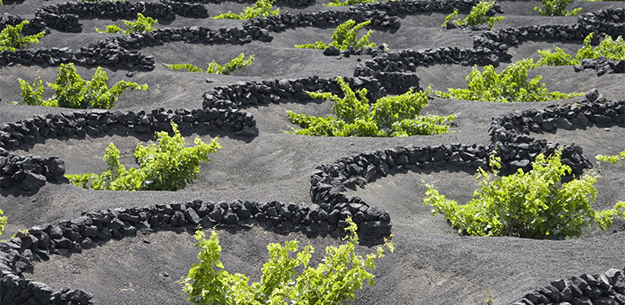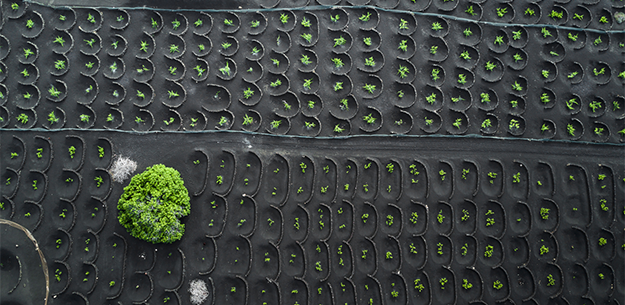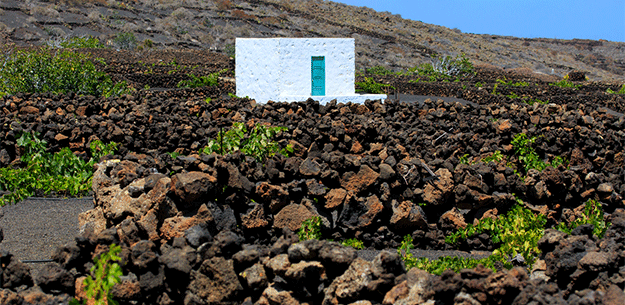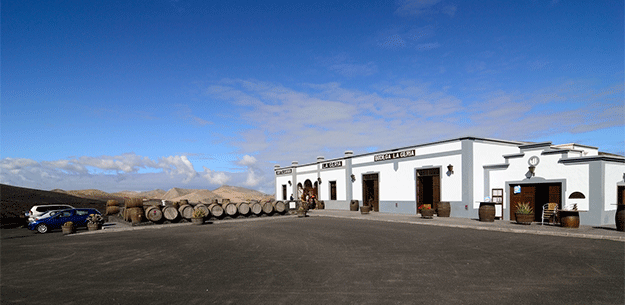.png.transform/rendition-xs/image_image%20(1).png)
Lanzarote Wines: Volcanic Treasures
The grapes used to make DO Lanzarote wines are cultivated in a singular manner, yielding equally unique wines, particularly those made from the predominant white Malvasía Volcánica grapes. It takes less than thirty minutes to drive this wine route from start to finish, but we recommend taking your time to savor each and every stop along the way.
Text: Adrienne Smith/®ICEX

Lanzarote is an arid, wind-swept panorama of blackened and rust-colored landscapes, so rocky and impenetrable-looking in places that the sight of green serves as a shocking reminder that you aren't on Mars, but rather the easternmost Canary Island. This is particularly true in the area surrounding the still-active volcano Timanfaya. Now a national park and part of the UNESCO Biosphere reserve that covers the entire island, Timanfaya's last massive eruption was in the 1730s, when it blanketed the area in a vast expanse of volcanic ash. It is here, skirting the eastern edges of the national park, that most of Lanzarote's vineyards and wineries are located, the roots of the vines improbably stretching down through the ash to find soil, thanks to funnel-shaped pits carved out of the lapilli – each containing a single vine – that are sheltered from the wind by individual, circular or semi-circular stone walls called zocos. This creates a sort of rippled-wave effect on the landscape, which is as stunning as it is virtually indescribable; I always think of the moon, as more terrestrial comparisons elude me.
Despite these difficulties and the obvious fact that the grapes must be harvested and cared for entirely by hand, the vines also benefit from the ash's ability to retain the scarce amount of humidity found in this dry climate, reduce evaporation, trap heat and even absorb moisture from the air; creating a perfect symbiosis that yields the island's characteristic dry, or naturally sweet white wines – typically made with Malvasía Volcánica (also known as Volcanic Malmsey) or Moscatel grapes, in addition to a few other native varieties like white Listán and Diego – some rosados and reds made primarily with red Listan Negro grapes; a few sparkling wines, and also some dessert wines and liquors. Incidentally, this is the earliest wine grape harvest in Europe.
Following the LZ-30: La Geria and Rubicón wineries

Driving the 16-kilometer (10-mile) stretch of the LZ-30 highway between the town of Uga and the famous Monumento al Campesino monument – designed by celebrated Lanzarote artist César Manrique in the 1960s as a tribute to the island's farmers – is unlike any other wine route in the world. The same can be said for the wines. The following are just a few stops on this route through the volcanic wine producing area of La Geria, one of three in Lanzarote (the others are the nearby Masdache and the northern Ye-Lajares), which boasts a total of seventeen DO Lanzarote wineries and some 2,000 hectares of vineyards. Even when spending just a couple of days on the island, you have more than enough time to visit them all.
Starting near the town of Uga in the municipality of Yaiza and approaching the route from the south, one of the first wineries you will come to is Bodega La Geria. With breathtaking views of Timanfaya National Park in the background, Bodega La Geria offers visitors a guided tour of its traditional, 19th-century structure and technologically-advanced wine making installations and cellars. The tour ends with a wine tasting from its range of more than a dozen wines, which include various dry, semi-dry and sweet whites made from either Malvasía or Moscatel grapes, a rosé and a range of three reds of varying intensities, and two organic wines, one red and one white. Just across the highway, Bodegas Rubicón offers visits of its grand 17th century country house and wine-making facilities. The winery also has a restaurant that serves up traditional Canarian dishes and tapas made with fresh, local ingredients; which can be enjoyed on a terrace overlooking the vineyards and the National Park. Be sure to accompany your meal with any of the wines from the winery's three brands Rubicón, Malpei and the splendid Amalia, some of which have won international wine awards.
A quick detour: Vulcano and Vega de Yuco wineries

Continuing on the LZ-30, you can veer off to the right just up the road on the LZ-501 for a small detour and a taste of the crisply dry, award-winning Malvasía wines in the tasting "boutique" found at Bodegas Vulcano de Lanzarote in the town of Tías (only about ten minutes by car). While here, place your order for when you get home, as the winery ships to mainland Spain and Europe. Then, drive back up to the LZ-30 another twelve minutes or so on the rural highway that leads past the Montaña Blanca volcano and Bodegas Martinón and Bodegas Vega de Yuco – the latter of which makes the dry and semi dry versions of Yaiza Malvasía, the award-winning wines that come in the distinctive blue, flute-shaped bottle you will remember from restaurants all over the island. Bodegas Vega de Yuco has a shop where you can purchase anything from its range of wines, but it is best to contact all three of these wineries in advance to arrange a tour.
History and wine: El Grifo and Los Bermejos wineries

Back on the LZ-30, the next stop has to be Bodegas El Grifo, the oldest winery in the Canary Islands and arguably the most famous of the wineries on this route. This is due in part to the multiple national and international awards garnered by its different wines, as well as their presence in both mainland Spain and beyond Spanish borders. Additionally, the winery boasts a library with 5,000 books about wine, and a fascinating wine museum, which includes the original wine cellar that dates back to 1775, the year this family winery was founded. In addition to the museum, the tour includes a first-hand look at the special techniques used in the vineyards. It is best to reserve the tour in advance, or you can just stop by the shop, which has a small bar where you can taste any of El Grifo's wines: from the most-recognizable dry Malvasía to the barrel fermented version, the sparkling Malvasía or sparkling (or still) rosés made with Listán Negra; and various other whites, reds and dessert wines.
Last on our tour, follow the bumpy country road behind El Grifo, or get back on the LZ-30 for a couple of minutes before taking the first hard left off the highway. This will take you to Bodegas Los Bermejos, another winery with international projection. Vineyards grace both sides of the narrow road, the green of the vines popping out at you from holes lined with shiny black soil. Located in a stately country manor, Los Bermejos' wines are as elegant as the setting. Dry, semi-sweet, barrel-fermented and sparkling Malvasía wines; sparkling and dry versions of rosé made with Listán Negro grapes, and two carbonic maceration reds – one of which is aged for four months in French oak. The winery also makes organic versions of several of the aforementioned wines, as well as a regular and organic version of a single-variety white wine made with native grape variety "Diego" – which I've never seen anywhere else. Visitors can stop in to purchase wine, or to enjoy a glass on the peaceful outdoor terrace. I would recommend doing both.
From here, depending on how many bottles you've purchased along the way, it's always a good idea to make the eight-minute drive to the offices of the Regulatory Council of Denomination of Origin Lanzarote Wines in the nearby town of San Bartolomé. Here you can purchase (I paid two euros) fantastic, reinforced wine boxes that can fit either two- or three-bottles each, and safely checked with the rest of your luggage. And if you can't help but enjoy your purchases before you go, it's only a hop, skip and a jump back down the LZ-30 to replenish with more excellent DO Lanzarote wines before catching your flight home (I should know).


